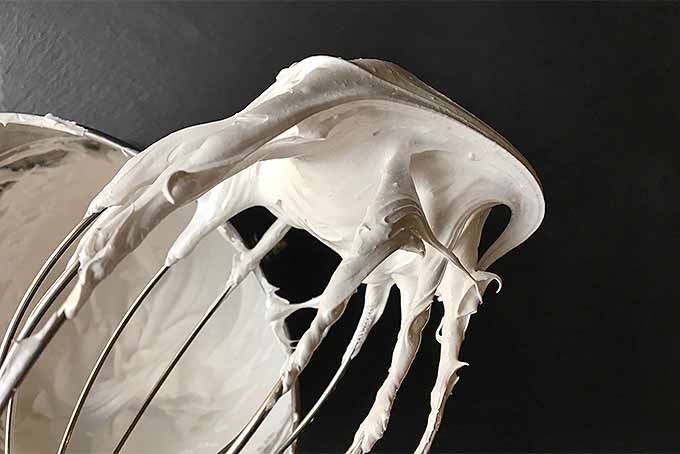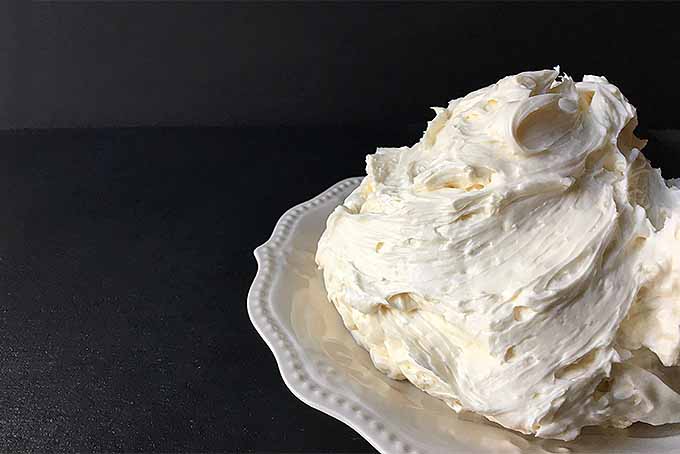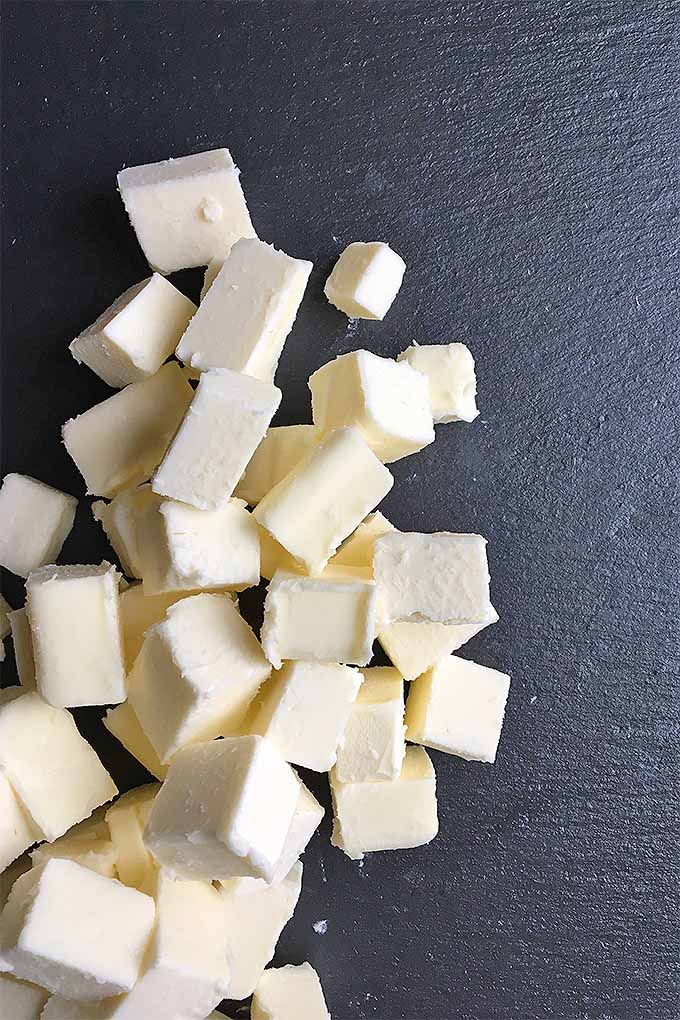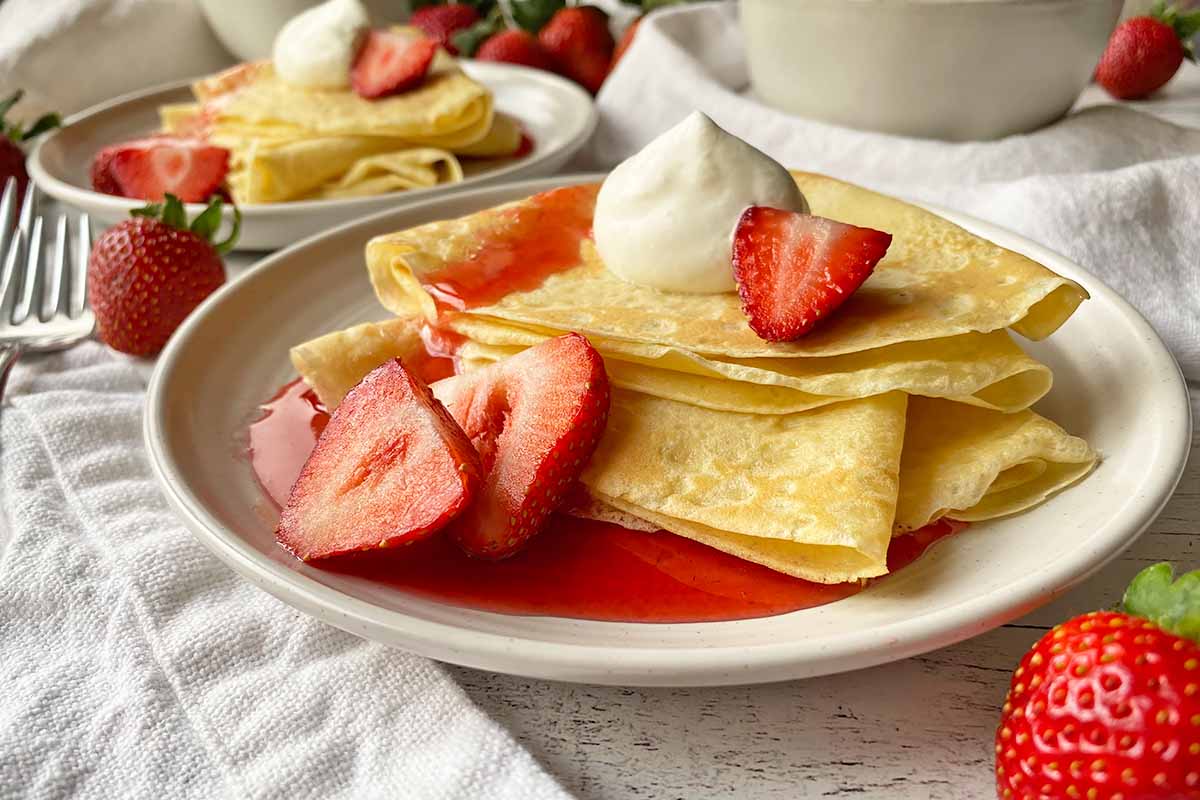Jump to the Recipe
If you are looking to try a different style of frosting to decorate your next cake or batch of sugar cookies, ready your pastry bags now for this Swiss meringue buttercream.

Its silky, light, melt-in-your-mouth texture and subdued sweetness is an elegant alternative to other kinds of frosting, like thick and sugary cocoa fudge or American-style buttercream.
This creamy decoration falls under the category of meringue buttercreams, which consist of two main components: butter and a soft meringue (a mixture of egg whites and sugar).
There are two main styles: Italian and Swiss. These refer to two different techniques that are used when making a meringue.

While you can make a simple meringue by whisking raw egg whites and sugar together, Italian and Swiss are two entirely different applications that involve cooking the egg whites, in order to form a more stable end result with better volume.
Keep reading to learn more about this delicious dessert topping, and find out how to make your own at home.
When in Rome…
Italian meringue is made by slowly pouring hot sugar syrup into egg whites while constantly whisking.
The hot sugar syrup gradually cooks the egg whites, while the whisking helps to cool and harden the sugar, and stiffen the whites.
You can use the finished meringue as is for decorating purposes, but you can also take the additional step of adding butter to make a buttercream.
A big battalion of softened butter is gradually added to the cooled meringue, and whisked vigorously until thick and fluffy.
Bada bing, bada boom – you’ve got smooth and tasty buttercream!
Savvy Swiss Style
Swiss meringue is made by gently cooking together sugar and egg whites over a double boiler.

After all the sugar dissolves and the mixture is slightly warmed, it is then whisked off the heat until a meringue develops.
Just like the Italian version, you can use it on its own for decorating, or you can gradually add softened butter while whisking to make a buttercream.
We provide a delicious recipe for this version below. Overall, it’s an easier style to make in comparison to the Italian version.
You don’t have to worry about making a hot sugar syrup, or painstakingly pouring it into a mixer with a high-speed whisk crazily flinging the syrup around the inside of the bowl, and inevitably dripping down the outside of it as well.
Maybe I should work on my aim…
Not today, painful hot sugar burns! If this sounds like it’s for you, might we suggest consulting our guides to kitchen safety and cleaning small kitchen appliances first?
We’ll stick with the delicious, and much easier, Swiss style.
A Few More Things to Consider…
Wait – There’s Egg in My Frosting?!?
Yes, and you’ll love it!
Eggs, especially when they are in the form of a delicious meringue, help to create that wonderfully silky texture.
The high protein content in the egg whites also provide more stability, volume, and thickness – qualities that are needed to perfectly frost and pipe your pastries!

The eggs are gently cooked with the sugar over the double boiler, but don’t overcook them! If overcooked, they will develop an egg-y taste and gumminess, and ruin the structure of the meringue.
Do you really want sugary scrambled egg whites?
Nah, didn’t think so.
Slowly Incorporate Softened Butter
This is one of the most crucial rules for making the smoothest, dreamiest, and creamiest buttercream.
You don’t want your butter to be cold straight out of the refrigerator, or else it will not incorporate properly. It will end up as sad chunks of fat floating around the egg and sugar. Epic fail #l.
On the other hand, you don’t want it to be too soft. Warm, liquid fat will essentially melt the meringue and ruin its stability and volume. Epic fail #2.
Prevent these fails by making sure your fat is at the right temperature. Success!
What you do want is room temperature, softened butter cut into tiny cubes to make it easy to drop in individual pieces.

You can leave it out at room temperature for at least 30 minutes before starting the recipe, or you can quickly soften it by placing it in the microwave for 10-second increments.
Remember – incorporate slowly.
While you have the mixer running on high speed to continuously mix in the fat, add just a few pieces at a time, waiting until they are all mixed thoroughly before you add more.
The mixture may look curdled as you continue to add the fat, but that’s normal. Just be patient, continue whisking, and work at a slow pace. It will soon emulsify together, with the more butter add and thorough mixing you do.
This creates the ultimate silky, buttery, wish-you-could-lather-it-all-over-your-body buttercream!
A Touch of Liquid
A small amount of acidity helps the stabilizing process when all ingredients are mixed together. The lemon juice in this recipe achieves that. It also helps to maintain that gorgeous bright white coloring once the frosting is fully whisked.
With the addition of the strongly aromatic vanilla, the flavor of the buttercream will be beautifully balanced.
Storage Tips
If you are planning to use your buttercream the same day you make it, you can leave it out at room temperature in an airtight container.
Refrigerate it instead if you plan to use it within a week. For long term storage, you can freeze it for up to one month.

Because it hardens in cool storage temperatures, leave your Swiss meringue out to thaw for at least 1 hour before decorating, so that it may soften.
After an hour, whip the icing for a few minutes in a stand mixer fitted with a whisk attachment to reincorporate some air.
Variations
Once you’ve got the basics down, why not try expanding your repertoire with a variety of delicious flavors? Follow the recipe below, with one of these additions or substitutions.

Chocolate: Thoroughly mix 2 1/2 ounces of melted unsweetened chocolate that has been slightly cooled into the finished buttercream.
Extracts: Replace the vanilla extract with your favorite flavor extracts or oils. Peppermint or almond flavorings are great choices.
Citrus: Add two tablespoons of orange, lime, or lemon zest to the finished product.
Liqueur: Starting with 1 tablespoon, add more according to taste. Try kirsch, rum, brandy or orange liqueur.
It’s time to prep the double boiler, soften that butter, and crack a few eggs – let’s make some buttercream right now!
The Recipe

| Servings | Prep Time |
| 12 servings | 5 minutes |
| Cook Time |
| 35 minutes |
|
|

|
What do you get when you combine butter and meringue? A delicious frosting. Get the recipe for smooth and silky Swiss meringue buttercream now on Foodal.
|
- 6 ounces egg whites
- 12 ounces sugar
- 1 pound, 5 ounces butter softened and cut into small cubes
- 3/4 teaspoon Lemon juice
- 1 1/2 teaspoons vanilla extract
- Prepare a double boiler. When the water starts to steam, combine the egg whites and sugar and cook over the steam, beating constantly with a hand whisk until all the sugar completely dissolves, and the mixture reaches about 145°F.
- Transfer the mixture to the bowl of a stand mixer with the whisk attachment. Whip at high speed until soft peaks form and the meringue is completely cool, about 10-15 minutes.
- Adding just a few pieces at a time, incorporate the soft butter into the meringue and continue to whip at high speed. Scrape down the sides of the bowl if the butter sticks. Whip until all of the butter is incorporated and the mixture is smooth, light, and fluffy, about 10 minutes.
- Add the lemon juice and vanilla extract and whip to completely incorporate, about 5 minutes.
- Use immediately or store for later use.
Nutritional Information*
Cooking by the Numbers…
Step 1 – Cook the Egg Whites and Sugar
Prepare a double boiler: fill the bottom pot a little less than halfway with water and place on the stovetop over medium-high heat.
As soon as it starts to steam, combine the egg whites and sugar and gently cook over the steam in a heatproof metal bowl, whisking constantly.

Once the sugar completely dissolves, and the mixture is warmed throughout, take it off the heat.
Confirm that the mixture is ready in two ways:
1. A thermometer inserted in the mixture reads 145°F.
2. Rub a small amount of the mixture between two fingers. If it feels completely smooth and has a thin, slimy, gooey texture, it is ready.

Step 2 – Whip to Make Meringue
Immediately transfer the mixture to the bowl of a stand mixer fitted with a whisk attachment.
Whip at high speed until a meringue is formed. It will develop a pure white color, with soft peaks.

Continue to whip until it is completely cooled. You can feel the heat at the bottom of the bowl – once it’s cold, move on to the next step.
Step 3 – Incorporate Butter
With the mixer running on high speed, add a few cubes of softened butter to the meringue, about three or four pieces at a time.
Only add more pieces after the ones added previously have been completely incorporated.

Occasionally scrape down the sides of the bowl with a spatula if the butter pieces stick to the sides and have not been combined.
The mixture may start to look curdled after a few butter additions. Continue to mix and add butter at a slow pace until it becomes soft and fluffy.
Step 4 – Add Additional Ingredients
When all of the fat has been incorporated, add the lemon juice and vanilla. Scrape down the sides of the bowl, and whisk again to incorporate.

Continue to whip until completely smooth and fluffy.
Step 5 – Use and Store
Use immediately for decorating. If using later on the same day, store at room temperature in an airtight container.

If using within one week, store in the refrigerator. When ready to use, bring to room temperature for one hour, then re-whisk for a minute in the bowl of a stand mixer to reincorporate air.
For long term storage, the buttercream can be frozen for up to one month. Thaw it in the refrigerator overnight, and then proceed with the prep technique described above for use after refrigerator storage.
Silky-Smooth Results
It may look very similar to traditional American-style buttercream frosting, but it is a completely different flavor and texture experience.
For a smooth and luscious coating on your favorite desserts, like chocolate cake or vanilla cake, you need to try this recipe, not to mention all of the yummy variations!

Be sure to follow all of our advice, and keep your refrigerator well-stocked with lots of butter. If you need some extra help with choosing the right tools, read our review of the best decorating tools every baker should own!
An, um, don’t tell anyone I told you this, but… if you are struggling with making buttercream, or if you don’t even like buttercream, quietly make your own to my article on an easy frosting-free way to decorate cupcakes!
And don’t forget to post what you think of the recipe in the comment section below!
Don’t forget to Pin It!

Photos by Nikki Cervone, © Ask the Experts, LLC. ALL RIGHTS RESERVED. See our TOS for more details.
*Nutritional information derived from a database of known generic and branded foods and ingredients and was not compiled by a registered dietitian or submitted for lab testing. It should be viewed as an approximation.
About Nikki Cervone
Nikki Cervone is an ACS Certified Cheese Professional and cheesemonger living in Pittsburgh. Nikki holds an AAS in baking/pastry from Westmoreland County Community College, a BA in Communications from Duquesne University, and an MLA in Gastronomy from Boston University. When she's not nibbling on her favorite cheeses or testing a batch of cupcakes, Nikki enjoys a healthy dose of yoga, wine, hiking, singing in the shower, and chocolate. Lots of chocolate.




Hi. Thank you for your explanation. I usually make the Italian buttercream but I have used Swiss meringue too. The only problem I have with these is that they seem smooth the moment I use them, but get hard soon and not so easy to work with the longer they sit. I have to rewarm the mixture a bit to create that smoothness again. I am wondering if I am using too much butter. Sometimes I go by the way the meringue looks in adding more or less, but I am thinking that if it gets too hard after it sits out for 30 to 45 minutes, then maybe it is a butter issue…